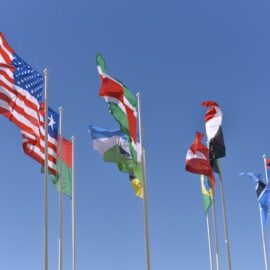

This article is an excerpt from the Shortform book guide to "A People's History of the United States" by Howard Zinn. Shortform has the world's best summaries and analyses of books you should be reading.
Like this article? Sign up for a free trial here.
What was New Imperialism? Whom did it benefit, and how?
In A People’s History of the United States, historian Howard Zinn discusses how and why the US became an empire in the chapter “The Empire and the People.” He argues that this “New Imperialism” accomplished the goals of the elites.
Keep reading to understand Zinn’s argument.
The Empire and the People
Zinn writes about America’s New Imperialism in the chapter “The Empire and the People.” He explains that, for centuries, American expansion had been fueled by the frontier. This refers to the “free” land and resources of the West provided a way for enterprising capitalists to make and expand their fortunes. But, by the end of the 19th century, Zinn explains, the American frontier had closed. Land and wealth in the US were largely divided up among a select few elites. To continue increasing their wealth, elites had to start influencing and controlling other countries and peoples—they had to make America an empire.
(Shortform note: While the US Census officially announced the “closing of the frontier” in 1890 when the borders of the contiguous US were set, the government continued to take land from American Indians in the following decades. Reservations of land set aside by the government for Indian tribes shrank considerably, especially in the Rocky Mountain and Great Plains regions. This was in large part because of the Dawes Act, which broke up reservations by redistributing lands from tribes as a whole to individual American Indians—who would often choose or be forced to sell that land to non-Indians for economic reasons. Maps of Indian reservations in 1893 versus 2016 show the extent of this loss.)
Around the turn of the 20th century, the US engaged in a number of imperial projects, influencing, controlling, and even conquering other nations and colonies. These accomplished two major goals for elites: First, they created new markets for American goods and new sources of cheap labor and natural resources. Second, they attempted to soothe domestic unrest by appealing to patriotism and nationalism—if everyone thought of themselves as part of a collective American project, they would pay less attention to class divisions within the country.
While elites and major newspapers tended to support these projects, Zinn suggests popular opinion was mixed. Trade unions occasionally supported colonial ventures, believing they would improve business. On the other hand, the Socialist Party was staunchly against American imperialism, and many Black Americans sympathized with or even supported peoples oppressed by the US abroad, recognizing their common struggle.
For example, the 1898 Spanish-American War saw the US intervene in the Cuban Revolution to secure American economic interests in the region. After winning the war in 1902, the US secured control over newly independent Cuba’s government and economy. The US also annexed a number of other Spanish colonies following the war, including the Philippines—after stomping out Filipino resistance in a bloody three-year campaign.
(Shortform note: Early US imperial and colonial projects were part of New Imperialism, a wave of global imperial expansion in the late-19th and early-20th centuries. This period is distinct from the first wave of European imperialism, which lasted from the 15th to the early-19th century and led to the creation of colonial America. The first wave was followed by a lull in imperial expansion as Europe recovered and rebuilt from the Napoleonic Wars. Then, starting in the 1870s, major European powers began to aggressively compete for colonial possessions again, particularly in Africa and Asia. Improvements to transportation and communication in the decades since allowed empires of this era to rule far more territory and wealth than before.)

———End of Preview———
Like what you just read? Read the rest of the world's best book summary and analysis of Howard Zinn's "A People's History of the United States" at Shortform.
Here's what you'll find in our full A People's History of the United States summary:
- A bottom-up view of American history focusing on the people, not the politicians
- How Indigenous people, Black Americans, women, laborers, and activists lived
- Why social movements of the 60s and 70s failed to create lasting change






